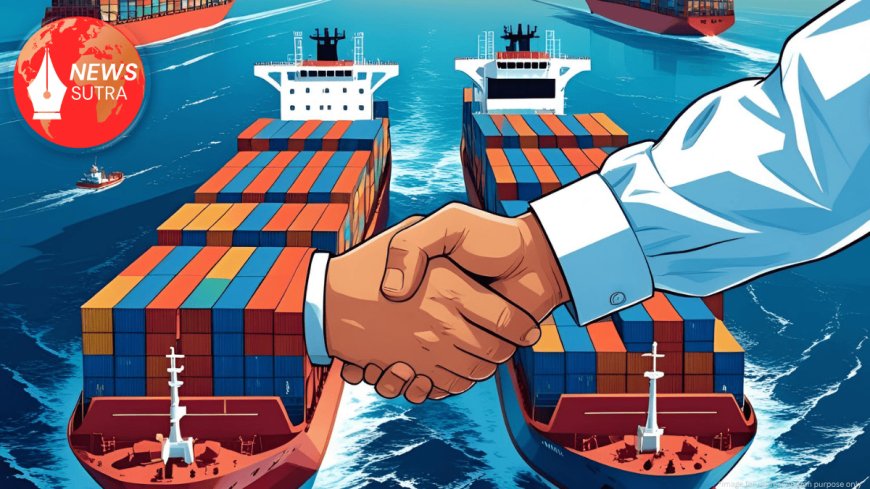India-China Reset: Strategic Calculations Amid Trump’s Renewed Trade Offensive
As Donald Trump reignites US-China trade tensions, India and China show signs of diplomatic recalibration. Explore the subtle shifts in foreign policy, recent engagements, and future strategic risks involved in this potential rapprochement.

With Donald Trump back in the White House and ramping up trade hostilities with China, global diplomatic equations are again in motion. One of the most closely watched relationships in this changing dynamic is that of India and China—two Asian powers that have often found themselves at odds geopolitically, militarily, and economically. Now, subtle signals suggest a possible thaw. But is this a genuine rapprochement or simply a tactical recalibration in response to external pressures?
This article delves into the current signals, recent policy shifts, and the risks involved as India and China navigate a precarious geopolitical landscape in 2025.
Diplomatic History: From Doklam to De-escalation
India and China have historically maintained a tense and complex relationship, marked by unresolved border disputes, conflicting regional ambitions, and growing economic competition. The 2020 Galwan Valley clash that resulted in the deaths of soldiers on both sides marked a significant low point. Since then, formal communications continued, but trust remained minimal.
However, in early 2025, the narrative began to shift. After Trump’s unexpected re-election and immediate renewal of tariffs on Chinese electronics and semiconductors, Beijing faced renewed isolation from the West. As the United States reactivates economic pressure on China, Beijing appears to be recalibrating its neighborhood strategy—including how it engages with New Delhi.
Signals of a Diplomatic Thaw
In the past three months, several significant developments have suggested a potential realignment:
1. Backchannel Communications Resume
Indian and Chinese diplomatic sources have hinted at a revival of backchannel talks, particularly on trade cooperation and cross-border military protocols. These discussions have not been publicly confirmed but are widely believed to be brokered by neutral third-party mediators such as Russia or ASEAN allies.
2. Bilateral Talks at SCO Summit
At the Shanghai Cooperation Organization (SCO) summit held in Astana in June 2025, Indian Foreign Minister S. Jaishankar and his Chinese counterpart Wang Yi met on the sidelines and held discussions that were “constructive,” according to official readouts. While border disputes were still mentioned, the emphasis was reportedly on improving trade logistics, enhancing cultural exchanges, and promoting multilateral regional security.
3. Trade Boost via Bhutan Transit Agreement
India’s new agreement with Bhutan to develop trilateral trade corridors, including indirect routes into Tibet, has surprisingly received muted reactions from Beijing. Analysts interpret this as a sign of China’s softened posture or a willingness to compartmentalize issues—border and trade separately.
Strategic Motivations Behind the Shift
Why would China pursue rapprochement with India now, after years of tensions?
1. Mitigating Western Isolation
Trump’s second term has revived a hostile trade environment for China. With Washington reinstating tariffs and tech bans, Beijing is eager to reduce dependency on Western markets. India, as a large consumer economy and non-aligned power, becomes a vital alternative.
2. Breaking the Quad’s Unity
The Quadrilateral Security Dialogue (Quad), comprising the US, India, Japan, and Australia, has been a thorn in China’s Indo-Pacific ambitions. A diplomatic opening with India could dilute India’s active alignment with Quad military objectives, especially in the Indian Ocean Region.
3. Border Stabilization as a Tactical Pause
Given internal economic stress, Beijing may seek a temporary de-escalation along the Line of Actual Control (LAC) to avoid fresh military confrontations. China’s economic focus in 2025 has shifted inward, with a push for urban debt reform and AI-led manufacturing revival.
India’s Calculated Caution
While China may have strong motivations for a thaw, India’s approach remains measured and rooted in strategic caution.
1. Border Trust Deficit
Indian defence analysts and former military officials have repeatedly cautioned against trusting China too quickly. The scars of Galwan and Doklam remain fresh in strategic memory. India continues infrastructure buildup near the LAC and remains engaged in joint military exercises with Quad nations.
2. Leverage from Global Standing
India’s recent chairmanship of the G20 and growing influence in global governance forums has given New Delhi a confident diplomatic voice. India is aware that any movement toward Beijing must not compromise its hard-earned global capital.
3. Balancing Act Between Trump and Xi
With Donald Trump renewing economic favoritism toward India—including proposed defense tech transfers and fast-tracked H-1B reforms—New Delhi cannot risk alienating Washington. Therefore, any engagement with China will be weighed carefully against potential disruptions in US-India ties.
Risks and Future Scenarios
While the current signals suggest a diplomatic opening, the risks of miscalculation remain real and significant.
Scenario 1: Tactical Rapprochement Followed by Renewed Friction
This is the most likely path: Both nations engage in limited, interest-based cooperation—mainly trade and environmental goals—but without resolving core disputes. Tensions could resurface abruptly, especially along the LAC.
Scenario 2: Sustained Strategic Engagement
A more optimistic path would involve serious structural dialogue. Confidence-building measures such as joint border patrol protocols, academic exchanges, and expanded tourism visas could set the stage for a longer-term strategic alignment.
Scenario 3: Reversion to Confrontation
A breakdown in talks or new provocation—such as infrastructure projects in contested zones—could reignite military confrontations. In such a case, Trump’s US would likely side openly with India, escalating the regional polarization.
Conclusion: Between Opportunity and Uncertainty
The India-China equation in 2025 is delicately poised. As Donald Trump reasserts America’s economic dominance through combative trade policy, regional actors like India and China are recalibrating their diplomatic postures. The subtle shift from confrontation to cautious dialogue between the two Asian giants may be born more out of necessity than genuine trust.
For India, the path forward involves leveraging its rising geopolitical stature while staying alert to the risks of Chinese unpredictability. For China, rapprochement with India could provide a much-needed diplomatic buffer as it braces against Western decoupling.
Whether this moment turns into a long-term thaw or merely a tactical pause will depend on how both nations manage competing interests, external pressures, and their shared—but often tense—history.



















































